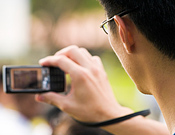OMVC Document Shows Potential for Mobile DTV

The Open Mobile Video Coalition (OMVC) has released version 1 of the OMVC Mobile Use Cases document [PDF]. This document describes the services possible using the ATSC M/H standard, ranging from the obvious “watch live TV” to the ability to subscribe to “Podcast” like streams of video and audio content.
Here is a sample of some of the use cases in the document and the example of how they could be used:
- 1.3Datacasting: A user stuck in traffic during the morning commute can access live local traffic data, including traffic maps, to decide whether or not to choose another course. A user can also access data of up-to-the-minute local weather, sports scores or stock and financial market information.
- 1.5Non-interactive Data Overlay: A user can view sports scores, ads, a stock ticker or news ticker displayed in either full screen boxes or as lower third graphics and L-Bar formats overlaid onto video.
- 2.1Clipcasting: A user selects Sports and News highlights in his clipcasting preference settings. When new content is available, he will receive an alert on his mobile device telling him when there are sports and news highlight clips waiting for him to view. He will be able to queue up the clips and watch them all in succession.
- 2.2Push VOD: A user creates a one-time subscription to “30 Rock” and “Lost.” Each time the user accesses the mobile device, he can watch the most recent episodes of each show he is subscribed to.
- 5.1Channel Change Interstitial: An image is displayed during the channel change to mitigate any perception that the change is taking a “long” time (maximum duration of 3 seconds). Longer term with a hold-me key and/or partitioning of the image with interaction linked.
- 5.3E-commerce: A purchasing opportunity is presented to the user. Interactivity allows the user to navigate to a Web page or application where an electronic commerce transaction may take place.
- 6.2Advanced Alerting: The user receives an alert that is geo-specific, not DMA-specific. Mobile devices should map to a common coordinate system in order for the broadcaster to send alerts in a timely manner (ex. GPS, cell tower triangulation).
- 6.3Wake Up: The device automatically wakes up when it is in listen mode to alert the user.
- 9.1Passive Viewer Data Collection: A log is kept in the background and sent to a server over some back channel. The user does not engage the measurement. The opt-in mechanism needs to meet legal requirements.
- 9.2Active Viewer Data Collection: The broadcast solicits users to respond to questions during or after a show. May be as simple as: Did you like the show? Yes / No and tell us about yourself.
As you can see from the numbers, this is only a small sample of what OMVC envisions for Mobile DTV. Some of the use cases will be more difficult to implement and device manufacturers will have to include the necessary software and hardware in cell phones, car entertainment systems, portable media players, notebooks, netbooks and other devices. A table at the end of the document provides a time frame for the different use cases and the service capabilities required before they can be implemented.
TheOMVC Mobile Use Cases document shows ATSC mobile DTV is much more than a replacement for live TV reception on yesterday's Sony Watchman or Casio handheld TV!
Get the TV Tech Newsletter
The professional video industry's #1 source for news, trends and product and tech information. Sign up below.

Doug Lung is one of America's foremost authorities on broadcast RF technology. As vice president of Broadcast Technology for NBCUniversal Local, H. Douglas Lung leads NBC and Telemundo-owned stations’ RF and transmission affairs, including microwave, radars, satellite uplinks, and FCC technical filings. Beginning his career in 1976 at KSCI in Los Angeles, Lung has nearly 50 years of experience in broadcast television engineering. Beginning in 1985, he led the engineering department for what was to become the Telemundo network and station group, assisting in the design, construction and installation of the company’s broadcast and cable facilities. Other projects include work on the launch of Hawaii’s first UHF TV station, the rollout and testing of the ATSC mobile-handheld standard, and software development related to the incentive auction TV spectrum repack. A longtime columnist for TV Technology, Doug is also a regular contributor to IEEE Broadcast Technology. He is the recipient of the 2023 NAB Television Engineering Award. He also received a Tech Leadership Award from TV Tech publisher Future plc in 2021 and is a member of the IEEE Broadcast Technology Society and the Society of Broadcast Engineers.
